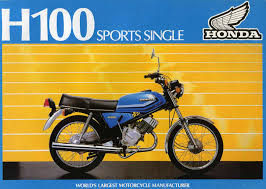At last it's bike of the week!
The Honda H100
Jerry Rulf
A two stroke little Honda? Cripes! They do 4 strokes though innit! WTH!
Introduced in 1980, the H100 was in production all through the Thatcher era until 1993, and was a bit of a departure for Honda, everyone being used to them making four strokes while the opposition did all the stinkbomb two strokes- so what made them go down the two stroke route?
Like Everest, because they could, or it was there, or hubris or something.
Two's company
The CB four strokes had already gained a great reputation and were made in loads of styles and capacities for all tastes. So, really. seriously, why the two stroke?
Honda were showing they could make any type of bike, and better, than their competition- and (apart from the dull styling) they did it. Later on they made rip roaring racey stuff like the NS400- it was like the other brands, except with Honda quality.
Of course Honda had made quite a few two strokes already, Honda having to admit, in 1972, that a two stroke was necessary for a competitive off roader, and the CR250 Elsinore was born. It always felt like they only made two strokes when they were forced to by circumstance, and the H100 was different in that respect; the CG and CB125 models were four strokes in commuter and sporty clothes, and were already acknowledged as top bikes, so the H100 remained a slight puzzle, where it fits in to the overall picture...
My first go on one was at 17- a friend had one with a Micron expansion chamber which crackled and burbled at a sound level close to a jumbo jet- and I was impressed! It really took off when the pipe came on song.
I was used to bikes not starting very easily, and breaking down about every week, and this reliable and quick bike was something of an eye opener for me.
It was also light, and joy of joys you didn't have to mix the oil in with the petrol yourself!
No smoking!
As early as 1951 Soichiro Honda himself had labelled the two stroke "primitive" but by 1980 technology had made the stinkers pretty civilised- The Honda featured a reed valve induction, automatic oil lubrication, a balancer shaft, and benefited from well designed porting. With modern oil, they don't even smoke!
Although producing a modest 10hp, it was intended as a general run around and commuter, as shown by it's (initially) enclosed final drive chain. Up to 100mpg and being properly reliable made it a simpler alternative to the four strokes on offer, but was it really much different from, say, the Yamaha 100 range at the time?
The answer is not really, and to a younger rider, the Yamahas looked a touch more Chip Shop.
The design was unremarkable but good- the engine hanging from a spine type frame, conventional wire wheels, smallish 18mm Keihin carb, drum brakes, kickstart and 6volt electrics.
A 70mph top speed (on the flat, with perhaps a following breeze) means they are perfect around town, and if you find yourself on a bit of dual carriageway then it's not dangerously slow either.
Spares are easy to get and even rustables like mudguards are available, so restoring a cheap old garage find is straightforward and not expensive. As all "classics" are increasing in value, these little jewels are a simple way to get into restoring and rebuilding, and are overlooked by trendsetters, with the result that you can pick one up for very little when compared with a decent CB125s (£1800 anyone?)
I would say (as with all two strokes) only ever use fully synthetic oil, and it will bomb along for as long as you want.
There must be lots of younger riders out there who are unacquainted with the particular advantages and feeling of a two stroke, and this bike is a good a gentle introduction to this world. And cheap! The only thing is, probably better not to hang around outside the Chippie with all the teenagers on their scooters. You know.
[email protected]


